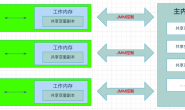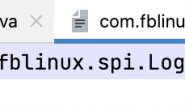1.LRU 算法简介
LRU是Least Recently Used的缩写,即最近最少使用,是一种常用的页面置换算法,选择最近最久未使用的页面予以淘汰
LRU算法的设计原则是:如果一个数据在最近一段时间没有被访问到,那么在将来它被访问的可能性也很小。也就是说,当限定的空间已存满数据时,应当把最久没有被访问到的数据淘汰。
常用与缓存数据的淘汰
2.LRU的思想
1、所谓缓存,必须要有读+写两个操作,按照命中率的思路思考,写操作+读操作的时间复杂度都需要为O(1)
2、特性要求
- 比如要有顺序之分,区分最近使用和很久没有使用的数据排序
- 写和读操作一次搞定
- 如果容量满了要删除最不常用的数据,每次新访问还要把新的数据插入到队头(按照业务决定左右那一边是队头)
LRU 算法的核心是哈希+链表:本质就是HashMap+DoubleLinkedList,时间复杂度是O(1),哈希找一次就可以找到,满足我们查找快的需求,双向链表保证增删比较快。所以查找用哈希增删用链表,这样就比较方便
3.LinkedHashMap实现LRU
LinkedHashMap就是LRU算法的体现
LinkedHashMap底层就是用的HashMap加双向链表实现的,而且本身已经实现了按照访问顺序的存储。此外,LinkedHashMap中本身就实现了一个方法removeEldestEntry用于判断是否需要移除最不常读取的数,方法默认是直接返回false,不会移除元素,所以需要重写该方法。即当缓存满后就移除最不常用的数。
import java.util.LinkedHashMap;
import java.util.Map;
public class LRUCacheDemo<K,V> extends LinkedHashMap<K,V> {
// 缓存的容量
private int capacity;
// 构造器方法
/* capacity:指定缓存的容量
loadFactor:负载因子,HashMap默认是0.75 这里不做修改
accessOrder:访问顺序
true:按照访问顺序将数据设置为最活跃
false:按照插入顺序将数据设置为最活跃
*/
public LRUCacheDemo(int capacity) {
super(capacity,0.75F,false);
this.capacity = capacity;
}
// 过期数据清理方法:HashMap里面的数据大于自己定义的容量,则删除最近最少使用的数据
@Override
protected boolean removeEldestEntry(Map.Entry<K, V> eldest) {
return super.size() > capacity;
}
public static void main(String[] args) {
LRUCacheDemo lruCacheDemo= new LRUCacheDemo(3);
// LinkedHashMap继承了HashMap的get和put方法,所以代码中可以不写,直接调用
lruCacheDemo.put(1,"a");
lruCacheDemo.put(2,"b");
lruCacheDemo.put(3,"c");
System.out.println(lruCacheDemo.keySet());
lruCacheDemo.put(4,"d");
System.out.println(lruCacheDemo.keySet());
lruCacheDemo.put(3,"c");
System.out.println(lruCacheDemo.keySet());
lruCacheDemo.put(3,"c");
System.out.println(lruCacheDemo.keySet());
lruCacheDemo.put(3,"c");
System.out.println(lruCacheDemo.keySet());
lruCacheDemo.put(5,"e");
System.out.println(lruCacheDemo.keySet());
}
}
列表中最左边的数据是最近最少使用数据,右边是最经常使用数据
accessOrder为true
[1, 2, 3] [2, 3, 4] [2, 4, 3] [2, 4, 3] [2, 4, 3] [4, 3, 5]
accessOrder为false
[1, 2, 3] [2, 3, 4] [2, 3, 4] [2, 3, 4] [2, 3, 4] [3, 4, 5]
4.手写LRU
import java.util.HashMap;
import java.util.Map;
public class LRUCacheDemo{
// map负责查找,构建一个虚拟的双向链表,它里面安装的就是一个个Node节点,作为数据载体
// 1、构造一个Node节点,作为数据载体
class Node<K,V>{
K key;
V value;
Node<K,V> prev;
Node<K,V> next;
public Node(){
this.prev = this.next = null;
}
public Node(K key,V value){
this.key = key;
this.value = value;
this.prev = this.next = null;
}
}
// 2、构建一个虚拟的双向链表,里面安放的就是我们的Node
class DoubleLinkedList<K,V>{
Node<K,V> head;
Node<K,V> tail;
// 构造方法
public DoubleLinkedList(){
head = new Node<>();
tail = new Node<>();
head.next = tail;
tail.prev = head;
}
// 添加到头
public void addHead(Node<K,V> node){
node.next = head.next;
node.prev = head;
head.next.prev = node;
head.next = node;
}
// 删除节点
public void removeNode(Node<K,V> node){
node.next.prev = node.prev;
node.prev.next = node.next;
node.prev = null;
node.next = null;
}
// 获得最后一个节点
public Node getLast(){
return tail.prev;
}
}
private int cacheSize;
Map<Integer, Node<Integer,Integer>> map;
DoubleLinkedList<Integer,Integer> doubleLinkedList;
public LRUCacheDemo(int cacheSize){
// 设置缓存容量
this.cacheSize = cacheSize;
// 查找
map = new HashMap<>();
doubleLinkedList = new DoubleLinkedList<>();
}
// 查找方法
public int get(int key){
// 如果没有这个key则返回-1
if (!map.containsKey(key)){
return -1;
}
// 返回数据,并且将数据从当前位置移除,添加到队头
Node<Integer, Integer> node = map.get(key);
doubleLinkedList.removeNode(node);
doubleLinkedList.addHead(node);
return node.value;
}
// 保存以及更新方法
public void put(int key, int value){
if (map.containsKey(key)) { // 更新操作
Node<Integer, Integer> node = map.get(key);
node.value = value;
map.put(key,node);
doubleLinkedList.removeNode(node);
doubleLinkedList.addHead(node);
} else {
if (map.size() == cacheSize){ // 容量满了
Node<Integer,Integer> lastNode = doubleLinkedList.getLast();
map.remove(lastNode.key);
doubleLinkedList.removeNode(lastNode);
}
// 新增操作
Node<Integer, Integer> newNode = new Node<>(key, value);
map.put(key,newNode);
doubleLinkedList.addHead(newNode);
}
}
public static void main(String[] args) {
LRUCacheDemo lruCacheDemo= new LRUCacheDemo(3);
lruCacheDemo.put(1,1);
lruCacheDemo.put(2,2);
lruCacheDemo.put(3,3);
System.out.println(lruCacheDemo.map.keySet());
lruCacheDemo.put(4,4);
System.out.println(lruCacheDemo.map.keySet());
lruCacheDemo.put(3,3);
System.out.println(lruCacheDemo.map.keySet());
lruCacheDemo.put(3,3);
System.out.println(lruCacheDemo.map.keySet());
lruCacheDemo.put(3,3);
System.out.println(lruCacheDemo.map.keySet());
lruCacheDemo.put(5,5);
System.out.println(lruCacheDemo.map.keySet());
}
}
程序输出结果如下:
[1, 2, 3] [2, 3, 4] [2, 3, 4] [2, 3, 4] [2, 3, 4] [3, 4, 5]
转载请注明:西门飞冰的博客 » LRU最近最少使用算法



